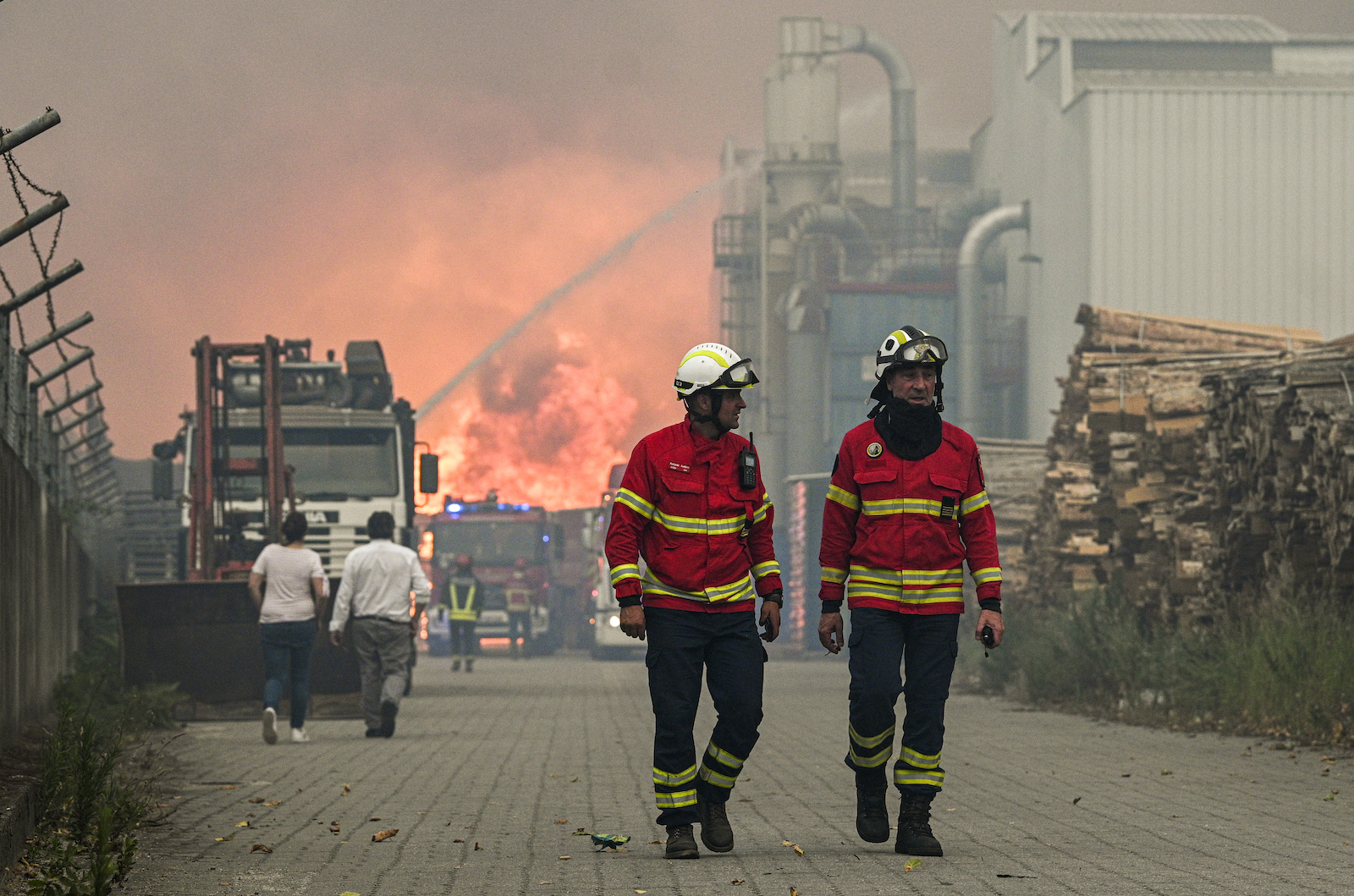To Achieve Resilience at the National Level, It Is Imperative to Look Beyond the Public Sector

Firefighters during a forest fire that has hit a timber factory on July 13, 2022 in Albergaria a Velha, Portugal. Wildfires have swept across the central part of the country amid temperatures exceeding 40 degrees celsius.
Photo by Octavio Passos/Getty Images
Of late, crises have arrived fast on top of one another — waves of COVID-19, prolonged global supply chain entanglement, conflict in Europe, and spiking energy and food prices that have driven up the cost of living. Not to ignore a summer of extreme heat, drought, and wildfires in North America, Europe, and China, and record rainfall in Pakistan and parts of Australia. Continually evolving cyber threats have been bumped from the spotlight.
Each crisis is one with different characteristics, each one with far-reaching and often interconnected reverberations, each one with compounding and cumulative effects. And each one illustrating the need not just for a “whole-of-government” response in sovereign states but for a “whole-of-society” response.
Concurrent contingencies have highlighted the need for governments to provide leadership and open their coffers at short notice. However, that is only part of the solution as governments inherently lack the financial and other resources needed to address complex crises by themselves. Indeed, claiming too much of that role for the public sector undermines the goal of building resilient economies and societies. More specifically, it can reinforce moral hazard and squander opportunities to mobilize the capabilities and energies that exist in other sectors — especially the private sector — to address critical challenges.
Moreover, while the pandemic reminded us repeatedly that good policymaking matters, successful outcomes in the face of critical risks also require the self-organizing adaptation, coordination and innovation across businesses, other organizations, and households to new emergency circumstances — trusting not only in government, but in each other too.
However, galvanizing and truly mobilizing different sectors is more easily aspired to than achieved. All too often, there’s a shortfall between assumptions and reality, plans and execution; moreover, good practices are hard to instill and can quickly wither.
Four ideas — derived from a report undertaken by Marsh McLennan with the United Kingdom’s National Preparedness Commission — might help governments and civil services chart a path forward.
Aligning Strategies with Goals
First, given how easy it is to be distracted by the shape-shifting nature of big risks with their hard-to-predict spill-over effects, governments should ground national resilience strategies with a clear view of what they want to achieve. Distinct goals might, for argument’s sake, focus on:
- Reducing broadly defined societal vulnerabilities — lessening the impact of potential disasters on communities and spurring faster, more equitable recovery from them
- Maintaining the reliability of critical ecosystems — functions, flows, and services that are often, but not exclusively, associated with the economic and societal infrastructure that underpin daily life
- Securing the nation’s long-term strategic imperatives — by developing the platforms (especially in emerging or fast-evolving fields) that can help the nation and its citizens enjoy freedom, security, and prosperity and enable its businesses to be competitive
Recent crises have prompted discussion — both favorable and concerned — about the trajectory toward bigger government and more dirigiste government. This is perhaps taking too narrow a frame.
Finding the Middle Way
Second, ambitions for a “whole-of-society” resilience require a conscious refresh of roles and responsibilities. Societal shortcomings and market failures in the light of more acute risks mean there are areas where governments need to be bolder in bringing about a more supple and supportive ecosystem. The scale of recent events has spurred governments to be both more assertive in mandating and regulating the activities of others and more wary of contingent liabilities that threaten public finances. However, in many countries, the greatest and most cost-effective opportunities might lie in a middle way — via initiatives that stimulate, nurture, and facilitate new interaction between public and private sectors and thereby leverage private sector finance, physical assets, workforce, capabilities, and innovation to build new underlying capabilities.
Indeed, the last few years have quickened the interest of many companies in these obligations and opportunities. Enlightened firms have begun to embrace more diverse resilience strategies, often taking greater steps to ensure the security of their supply chains, the health of their workforce, and the well-being of their customers. In responding to the pandemic, many deepened their engagement with local communities. Others have sought to pursue a more active role in addressing large-scale public policy challenges that can’t be resolved by government alone.
Closing Gaps and Accelerating Success
Third, it is important to review critical enablers that might help accelerate and expand this momentum. Stakeholders in key ecosystems need to find a better way of allocating risks. While taxpayers can’t be expected to bail out everyone in every crisis, it’s not viable either to always sweep risks off the public balance sheet onto the private sector. Plenty of examples illustrate where risk and resilience have notionally been outsourced by governments, but government still ends up managing the fallout from failure. Indeed, in some countries, the expectation among households and businesses that the government will cover them in a disaster has actually increased.
Two financial “protection gaps” need to be closed: between the needs of future national resilience and the current or proposed levels of investment (including insurance coverage), and between the solutions available and the affordability of those solutions for vulnerable affected communities. More transparent, analysis-led discussions about risks and tolerances will help prevent capital from going elsewhere and spur more equitable, creative solutions that deliver value — and value for money — over the long term, not just the short term.
In a similar fashion, industry regulatory arrangements often struggle with resilience imperatives. It is of course hard to take a systemic view when assets, asset owners, industries and systems are changing so rapidly, and it is hard to future-proof regulation at a time of very significant change. As a result, there are systemically important sub-sectors and firms that should experience greater oversight — something often only recognized when things go wrong. Moreover, unless long-term resilience is more thoroughly baked into regulatory regimes that primarily focus on protecting the pockets of present-day consumers, critical infrastructure players will likely fall short in developing and implementing cost-effective investment plans that anticipate both near- and long-term contingencies.
Collaborating and Communicating
Fourth, technical solutions need to be underpinned and amplified by a stronger culture of collaboration and better communication between public and private sectors. There are many good reasons for constraining flows of data and intelligence of different kinds, but greater openness between government and companies would likely yield new opportunities — supporting resilience analytics for critical infrastructure, ensuring the availability of strategic supplies in a crisis, and achieving more advanced risk scenario assessments, to name but a few examples.
Indeed, involving the private sector at an earlier point in government-led risk discussions might help flush out under-appreciated risks and cascading consequences, challenge traditional stove-piping tendencies within the public sector, and prompt greater innovation and broader traction with emerging solutions.
In conclusion, recent crises have prompted discussion — both favorable and concerned — about the trajectory toward bigger government and more dirigiste government. This is perhaps taking too narrow a frame. As governments and administrations draw lessons from recent crises and recognize the challenges ahead, they might focus not just on enhancing the capabilities and connective tissue within the public sector, but also on mobilizing the broader ecosystem that will deliver the outcomes desired.
A version of this article was first published on the Global Government Forum website.





